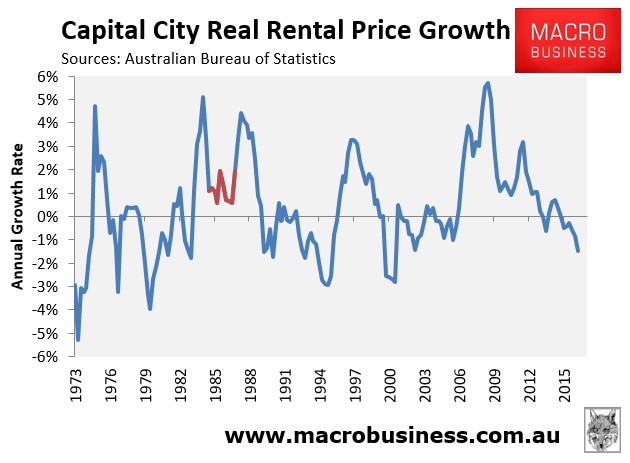One of the common arguments the property lobby makes against negative gearing reform is that rents would skyrocket if investors were no longer allowed to claim rental losses against their wage and salary income.
We saw this argument again in an article published on realestate.com.au, whereby an investor with 110 properties claimed that “rents will explode” by as much as 50% if negative gearing is removed.

“When they removed negative gearing in the 1980s, rents increased dramatically”, investor Eddie Dilleen claimed.
“It’s a terrible idea to remove it. It’s a stupid idea to remove it. It would make the rental crisis even worse than it already is at the moment”.
“In Australia, rents could jump as high as 50% if negative gearing gets removed”.
“If they did remove it, rents would explode and they would just be hurting and killing the renters out there”, Dilleen said.
Let’s think about Dilleen’s statements for a moment. If it were true that rents would “jump as high as 50% if negative gearing gets removed”, then surely all investors would support negative gearing’s removal? A 50% rise in income returns would represent a massive financial windfall.
The reality is that rents would be unlikely to move much at all. They certainly didn’t when negative gearing was temporarily abolished in the mid-1980s (see here for analysis).
According to the Australian Bureau of Statistics’ rental data, real inflation-adjusted rental growth only rose in Sydney and Perth (where vacancy rates were already low), whereas rental growth was flat or fell across the other capital cities.
There was also no impact nationally, with rental growth much higher both before and after the change (the period where negative gearing was abolished is shown in red below):

Indeed, the 1987 Cabinet Submission on negative gearing said the following about rental growth (my emphasis):
“Data for individual capital cities suggest that, as might be expected, rents have risen more rapidly in those cities where vacancy rates have been tightest”.
“In the twelve months to March quarter 1987, rent increases in six of the eight capitals lagged the CPI“.
Even in the heavily redacted Treasury advice to the former Turnbull Government, Treasury noted that “previous changes to negative gearing (1985-87) and the introduction of the capital gains tax discount had little discernible impact on the [housing] market”.
Negative gearing in the US also ended in 1986 with Ronald Reagan’s big-bang tax reform, which cut tax rates and broadened bases. The US economy and housing market survived.
Eddie Dilleen’s ludicrous claims follow those of Bharat Patel, who has amassed a portfolio of 32 homes and claims that changes to negative gearing would devastate the nation:

“You rely on these tax incentives and without them the whole economic system will fall apart”, said Patel.
“Negative gearing is the only vehicle for that sort of tax relief, and there will be no incentive to buy these properties without it”.
Patel’s grandiose claims are comical when you consider the reportedly modest scope of the Albanese government’s proposals, which would merely limit the number of homes a taxpayer can negatively gear.
Any reform would also be grandfathered, ensuring that existing investors were not affected. The reforms would merely discourage future investors from owning multiple properties.
In other words, they are insignificant and would merely temper future investor demand, thereby moderately increasing the share of first home buyers and the home ownership rate.

